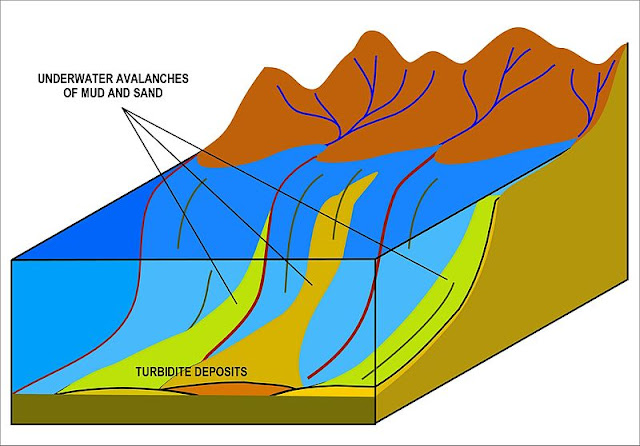Episode 396 Turbidity currents
Update: 2018-04-17
Description
As near as I can tell in the original daily series in 2014,
I never addressed the topic of turbidity currents and their sedimentary
product, turbidites. But they account for the distribution of vast quantities
of sediment on continental shelves and slopes and elsewhere.
You know what turbid water is: water with a lot of suspended
sediment, usually fine mud particles. In natural submarine environments,
unconsolidated sediment contains a lot of water, and when a slurry-like package
of sediment liquifies, it can flow down slopes under gravity, sometimes for
hundreds of kilometers.
It isn’t correct to think of these streams of water and
sediment as like rivers on the sea floor. Rivers transport sediment, whether
boulders or sand or silt or mud, through the traction, the friction of the
moving water. Turbidity flows are density flows, moving because the density of
the water-sediment package is greater than the surrounding water. That means
they can carry larger particles than usual.
 |
Sometimes a turbidity flow is triggered by something like an
earthquake, but they can also start simply because the material reaches a
threshold above which gravity takes over and the material flows down slope. The
amount and size of sediment the flow can carry depends on its speed, so as the
flow diminishes and wanes, first the coarse, heavier particles settle out,
followed by finer and finer sediments. This results in a sediment package
characterized by graded bedding – the grain size grades from coarse, with
grains measuring several centimeters or more, to sand, 2 millimeters and
smaller, to silt and finally to mud in the upper part of the package. Repeated
turbidity flows create repeated sequences of graded bedding, and they can add
up to many thousands of meters of total sedimentary rock, called turbidites.
Other sedimentary structures in turbidites can include
ripple marks, the result of the flow over an earlier sediment surface, as well
as sole marks, which are essentially gouges in the older finer-grained top of a
turbidite package by the newest, coarser grains and pebbles moving across it.
There are variations, of course, but the standard package of
sediment sizes and structures, dominated by the graded bedding, is called a
Bauma Sequence for Arnold Bouma, the sedimentologist who described them in the
1960s.
Turbidity currents are pretty common on the edges of
continental shelves where the sea floor begins to steepen into the continental
slope, and repeated turbidity flows can carve steep canyons in the shelf and
slope. Where the flow bursts out onto the flatter abyssal sea floor, huge
volumes of sediment can accumulate, especially beyond the mouths of the great
rivers of the world which carry lots of sediment.
When the flow is no longer constrained by a canyon or even a
more gentle flow surface, the slurry tends to fan out – and the deposits are
called deep abyssal ocean fans. They are often even shaped like a wide fan,
with various branching channels distributing the sediment around the arms of
the fan. The largest on earth today is the Bengal Fan, offshore from the mouths
of the Ganges and Brahmaputra Rivers in India and Bangladesh. It’s about 3,000
km long, 1400 km wide, and more than 16 km, more than 10 miles, thick at its
thickest. It’s the consequence of the collision between India and Eurasia and
the uplift and erosion of the Himalaya.
The scientific value of turbidites includes a record of
tectonic uplift, and even seismicity given that often turbidity currents are
triggered by earthquakes. They also have economic value. Within the sequence of
fining-upward sediments, some portions are typically very well-sorted, clean
sandstones. That means they have grains of uniform size and shape and not much
other stuff to gum up the pores between the sand grains – so that makes them
potentially very good reservoirs for oil and natural gas. You need the proper
arrangements of source rocks, trapping mechanisms, and burial history too, but
deep-water turbidites are explored for specifically, and with success, in the
Gulf of Mexico, North Sea, offshore Brazil and West Africa, and elsewhere. The
Marlim fields offshore Brazil contained more than 4 billion barrels of
producible oil reserves when they were discovered in the 1980s.
Ancient
turbidites sometimes serve as the host rocks for major gold deposits, such as
those at Bendigo and Ballarat Australia, which are among the top ten gold
producers on earth.
—Richard I. Gibson
Comments
In Channel





